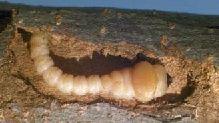Natural Solutions to Things That Bug You (38 page)
Read Natural Solutions to Things That Bug You Online
Authors: Myles Bader

APPLE PEST PROBLEM SOLVER



THE PROBLEM CAUSED BY
Brown granular material around core
that may leak out holes Codling moth
Leaves and blossoms tied up and eaten,
bronze-colored scars Leafrollers
Leaves eaten in spring, small gouges Western tussock moth
Irregular spots on upper side of leaves,
looks like blisters Tentiform leafminer
White cottony masses on woody areas of the
tree, warty growths on limbs and roots,
honeydew and black sooty mold Woolly apple aphid
New leaves distorted and curled, honeydew Rosy apple aphid
New growth stunted, honeydew present and
black sooty mold on leaves and fruit Green apple aphid
Pieces of apples missing Birds and squirrels

WE NEED A GOOD BAND
One of the best controls is to band the tree. In the spring use strips of corrugated cardboard to tempt the larvae looking for a place spin their cocoon. Wrap the bands in several thicknesses then tie them on firmly. The exposed ridges should be facing toward the tree, if not; the larvae will not spin a cocoon. In warm weather you should remove the bands every 2 weeks and in cool weather about every 3 weeks, then remove and kill the larvae.
SANITATION WORKS GREAT!
In the fall if you clean up any fallen fruit and leaves, it will remove their winter home.
MAKE A TRAP
To prepare a trap, mix together 4½ cups of tap water, ½ cup of honey, ½ cup of molasses and 1 tablespoon of fresh yeast. Place the mixture into an empty plastic milk bottle and cut an entrance hole near the top. Run a piece of rope through the handle and hang it in a tree. It takes about two traps per mature tree. Be sure and empty them weekly and keep them up for about 2 months.
 You can also use a special pheromone to trap them that can be purchased at your local garden supply.
You can also use a special pheromone to trap them that can be purchased at your local garden supply.
NOT ONLY FOR VAMPIRES
Spraying garlic is very useful in controlling the codling moth. The natural sulfur tends to repel them.
WASP THEM
Parasitic wasps are employed regularly to eliminate the codling moth larvae and pupae.
EUROPEAN APPLE SAWFLY
General Information:
The sawfly spends its winter under the soil as mature larvae in a cocoon and comes out in the spring as a fly. This is a brown and yellow bug with many transverse lines. It is somewhat larger than a common housefly and is active in the northeastern United States. The larvae live just under the skin of the fruit until they are about one-third grown and then bore into the fruit and do extensive damage before entering the soil.
extensive damage before entering the soil.
TRAP THOSE APPLE VARMENTS
Use white, sticky rectangular traps that can be purchased in most nurseries. This is the preferred method of elimination instead of poisons.
FLATHEAD APPLE BORER
General Information:
 This is a pest with a big appetite and will infest the following trees: apricot, cherry, boxelder, elm, hickory, chestnut, linden, oak, peach, plum, sycamore and willow. Their feeding tunnels will actually show through the bark in sunken areas. The larvae, is whitish-yellow and legless with several front body segments, which are wide and flat. They spend the winter in the fruit tunnels that they made.
This is a pest with a big appetite and will infest the following trees: apricot, cherry, boxelder, elm, hickory, chestnut, linden, oak, peach, plum, sycamore and willow. Their feeding tunnels will actually show through the bark in sunken areas. The larvae, is whitish-yellow and legless with several front body segments, which are wide and flat. They spend the winter in the fruit tunnels that they made.
The tunnels will eventually fill with a dry powder known as “frass,” which is composed of droppings and sawdust produced by their boring. The adults are dark bronze beetles that have a metallic sheen. The beetles come out in May and June and will relax on the sunny sides of the trees and lay their eggs in the crevices of the tree.
GET OUT THE BURLAP BAGS
Trees that have been transplanted and seedlings need to be protected with a wrapping of burlap or cardboard from the soil up to the lower branches.
PAINT THE TREES
You can apply a generous coating of white exterior latex paint to the tree trunk, protecting them from the bug.
ROUNDHEADED APPLE TREE BORER
General Information:
 This borer likes to tunnel deep into the trunk of the apple tree near the ground. Infestations will weaken a tree and can kill young trees. They will also eat both the leaves and the fruit. If you find brown castings above or just below the ground you know that they are active. If you do see the holes, snake a wire into the hole to kill them.
This borer likes to tunnel deep into the trunk of the apple tree near the ground. Infestations will weaken a tree and can kill young trees. They will also eat both the leaves and the fruit. If you find brown castings above or just below the ground you know that they are active. If you do see the holes, snake a wire into the hole to kill them.
SUDS-A-WAY
If you use a thick wash of soap applied to the lower trunk of the tree it will discourage the beetles from laying their eggs.
CATCH THE DROPPINGS
One of the best methods of reducing the problem with these bugs is to remove any fruit that has dropped on the ground. Most of the time when fruit drops prematurely it is due to an infestation.
HIRE A HOG